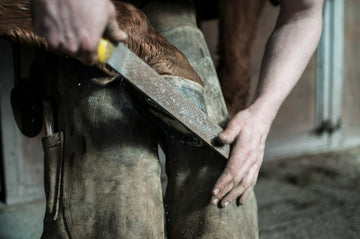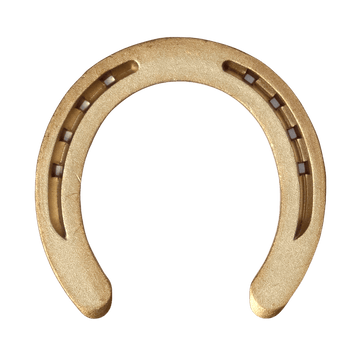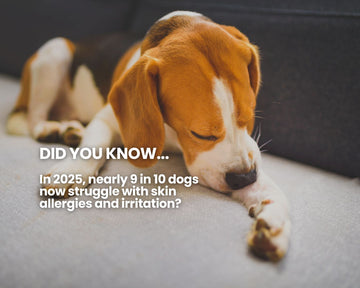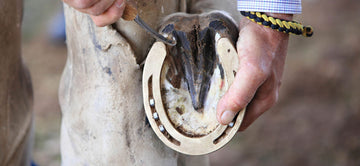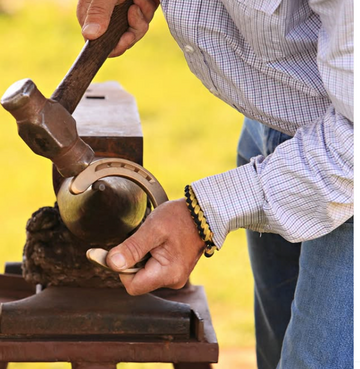Introduction to Hoof Health
Healthy hooves are the foundation of a horse’s overall well-being. A horse’s hooves support their movement, balance, and daily comfort, making hoof care a top priority for every horse owner.
Unfortunately, horse hooves are susceptible to a range of issues, with thrush being one of the most common and troublesome. Thrush is a bacterial infection that can quickly take hold in the hoof, especially if left untreated, leading to discomfort, infection, and even lameness.
Preventing thrush starts with understanding the importance of regular hoof maintenance. Daily cleaning, routine trimming, and providing a balanced diet all contribute to strong, resilient hooves. By taking these proactive steps, horse owners can help prevent thrush and other hoof problems, ensuring their horses stay healthy, active, and comfortable.
Remember, a little attention to hoof health goes a long way in preventing bacterial infections and keeping your horse’s hooves in top condition.

Understanding Thrush: A Common Yet Preventable Hoof Condition
Thrush is one of the most common and frustrating conditions that horse owners encounter. It is a common condition in horse hooves, frequently affecting the frog and surrounding sulci. Characterized by a foul-smelling black discharge and a deterioration of the frog, thrush is a bacterial or fungal infection that thrives in wet, dirty, and poorly maintained hooves.
Typical signs of thrush include black, foul smelling discharge, a strong foul smell, tenderness in the frog region, and visible structural changes. In more advanced cases, thrush can create deep pockets and fissures around the heel bulbs and central sulcus, which are key areas for diagnosis and treatment due to their susceptibility to infection. While it may start as a minor irritation, if left untreated, it can lead to lameness, pain, and long-term hoof damage.
The good news is that thrush is not only treatable—it’s preventable. With consistent hoof care practices and the use of innovative natural products, horse owners can create a clean, antimicrobial environment that discourages the growth of harmful microbes.
At Kawell USA, we believe in proactive hoof health. Our line of copper-based products—Copper Alloy Horseshoes, Copper Alloy Frog Inserts, and Horse Hoof Paste—are designed to work with your horse’s biology to naturally prevent and manage thrush without synthetic chemicals or harsh treatments.
What Causes Thrush in Horses?
Thrush is typically caused by anaerobic bacteria, which thrive in moist, oxygen-deprived environments like the frog sulci of a horse’s hoof. Contributing factors include:
-
Dirty or wet stall bedding
-
Poor hoof hygiene or infrequent cleaning
-
Overgrown frogs and deep sulci that trap debris
-
Lack of airflow in the hoof
-
Horses standing in mud, manure, or urine-soaked areas for prolonged periods
-
Excess moisture in the horse's environment
Certain hoof conformations, such as contracted heels or long heels, increase the increased risk of thrush by trapping debris and moisture. Horses living in muddy or wet environments, or where the horse lives is not well-drained, are more likely to develop thrush.
Thrush can affect the heel, heel bulbs, lateral sulci, and central sulcus, and may damage the digital cushion and other sensitive structures if left untreated. The infection can invade sensitive tissue, leading to permanent lameness if not addressed promptly. Thrush involves the breakdown of dead tissue in the frog and surrounding areas.
Symptoms of thrush include a black, tar-like substance, strong odor, sensitive frog, and sometimes visible lameness if the infection becomes severe.
To prevent thrush, it is important to keep the horse's feet, foot, horse's feet, horse's hoof, and horse's hooves clean and dry.
Managing the Environment: The First Line of Defense
When it comes to preventing thrush in horses, managing the environment is your first and most effective line of defense. Thrush in horses thrives in damp, dirty conditions, so it’s essential for horse owners to create a clean and dry environment for their animals.
Start by keeping stalls free of wet spots and soiled bedding—regularly remove manure and replace any damp materials to prevent moisture from accumulating. In turnout areas, try to minimize muddy ground and provide well-drained spaces where your horse can stand on dry footing.
Choosing the right bedding is also important, as some materials can trap moisture and increase the risk of developing thrush. Opt for bedding that stays dry and is easy to clean. Additionally, supporting your horse’s overall health with a balanced diet and access to fresh water helps strengthen their immune system and hoof tissue, making them less susceptible to infection.
By staying vigilant and maintaining a clean, dry environment, horse owners can significantly reduce the risk of thrush and support the long-term health of their horse’s hooves.
Daily Hoof Care to Prevent Thrush
The first line of defense against thrush is proper and consistent hoof care. Here are the fundamentals:
-
Clean hooves daily, especially in wet weather or when horses are housed in stalls.
-
Pick out debris from around the frog, paying close attention to the sulci (grooves).
-
Inspect for odor, tenderness, or visual signs of infection.
-
Keep stalls clean and dry, replacing soiled bedding promptly.
-
Ensure regular farrier visits to maintain proper hoof balance and trim excess frog growth.
With consistent daily care, issues like thrush are more likely to be caught early, allowing for prompt treating of any signs of infection. Maintaining a balanced hoof through regular farrier visits supports proper blood flow and overall hoof health. Incorporating daily exercise helps promote circulation and hoof health.
Supporting the hoof's natural cleaning mechanism by avoiding practices that interfere with self-cleaning is also important. During daily care, inspect the frog tissue and hoof wall for any signs of infection or damage.
In addition to basic care, adding natural antimicrobial protection to your routine makes a significant difference in preventing the recurrence of thrush.

Kawell USA Products for Thrush Prevention
Copper Alloy Horseshoes: Built-In Antimicrobial Defense
Kawell USA’s Copper Alloy Horseshoes are made from a patented copper alloy registered with the Copper Development Association (UNS Alloy No. C6915) and approved by the EPA (Registration #82012-3). These horseshoes kill 99% of bacteria and fungus on contact—including the microbes responsible for thrush.
Key Features:
-
Constant antimicrobial activity without wearing out
-
Helps prevent seedy toe, white line disease, and thrush
-
Reduces hoof-related veterinary and farrier costs
-
Absorbs 8.53% of impact shock per step
-
Eco-friendly and 100% recyclable
Unlike traditional steel shoes, copper alloy shoes work passively every time your horse takes a step, creating an unfriendly environment for thrush-causing organisms.
Copper Alloy Frog Inserts: Targeted Thrush Protection
When it comes to directly protecting the frog—the area most vulnerable to thrush—Kawell USA’s Copper Alloy Frog Inserts offer a breakthrough solution. Designed by American farrier Esco Buff, PhD, APF-I, CF, these patented inserts sit within the hoof to eliminate bacteria and fungi at the point of infection.
Why They Work:
-
Made of copper alloy that kills bacteria and fungi on contact
-
Prevents microbial buildup in the frog and collateral sulci
-
Fits seamlessly into heart bar shoes for added pressure and support
-
Recommended for horses with chronic thrush or deep sulci
These inserts are ideal for horses prone to thrush or recovering from recurrent infections. They are available in multiple sizes to suit different hoof shapes.
Horse Hoof Paste: Daily Nutrient and Moisture Balance
Kawell USA’s Horse Hoof Paste is made from pine oil, pine tar, petroleum jelly, and lard— ingredients that condition the hoof and protect against infection. It helps maintain the ideal moisture balance that discourages microbial growth while supporting hoof health and regeneration.
Benefits:
-
Prevents drying, cracking, and microbial intrusion
-
Nourishes the hoof horn and frog
-
Provides a physical barrier against environmental moisture
-
Can be used daily, especially in wet conditions
Apply the paste after cleaning and drying the hoof, focusing on the frog, sole, and bars. For horses already being treated with copper shoes or frog inserts, this paste enhances the hoof’s natural defenses and complements your overall care regimen.
Thrush Prevention Routine Using Kawell USA Products
Creating a preventive protocol is simple and effective. Here’s how to use Kawell USA’s products in a coordinated system:
Step-by-Step Guide:
-
Clean the hoof thoroughly using a pick to remove dirt from the frog and sulci.
-
Inspect for early signs of thrush (odor, discharge, frog softness).
-
Apply Hoof Paste to condition and protect.
-
Use Copper Alloy Horseshoes for horses that need regular shoeing.
-
Insert Copper Alloy Frog Inserts for horses prone to deep sulci or recurring thrush.
-
Monitor hoof condition daily, especially in wet or humid conditions.
This system offers a comprehensive, natural strategy for keeping hooves clean, dry, and thrush-resistant.
Treatment Options: What to Do If Thrush Strikes
If your horse develops thrush, prompt and thorough treatment is essential to prevent prolonged infection and the risk of lameness. The best treatment for thrush begins with daily cleaning—use a hoof pick to carefully remove dirt, debris, and any black discharge from the affected area, paying special attention to the frog and sulci. Keeping the hoof clean and dry is crucial for recovery.
Next, consult with your veterinarian or a certified farrier to assess the severity of the infection and determine the most effective treatment plan. This may include trimming away dead or infected tissue to promote healthy growth and applying a topical treatment specifically designed to target thrush. In severe cases, your veterinarian may recommend additional treatments, such as antibiotics or more intensive care, to address deep or persistent infections.
Throughout the treatment process, maintaining a clean environment and providing regular exercise will help support healing and prevent thrush from returning. By acting quickly and working with professionals, horse owners can treat thrush effectively and protect their horse’s hooves from long-term damage. Consistent hoof care and environmental management remain key to preventing future infections and ensuring your horse stays sound and comfortable.
The Long-Term Benefits of Natural Thrush Prevention
Choosing a natural approach offers both immediate and long-term advantages. Harsh chemical treatments may kill bacteria but often damage healthy tissue or disrupt the natural balance of the hoof. Kawell USA’s products instead support the hoof’s ability to fight infection on its own while strengthening its overall structure.
Advantages of Going Natural:
-
No harsh chemicals, stinging, or caustic agents
-
Promotes healthy frog and sole development
-
Safe for regular, long-term use
-
Reduces reliance on reactive treatments
-
Environmentally friendly, biodegradable formulations
Horses with strong, clean, and properly maintained hooves are more comfortable, more sound, and more capable of reaching their full athletic or working potential.
Frequently Asked Questions
What is the best way to prevent thrush in horse hooves?
The most effective way to prevent thrush is through a combination of daily hoof cleaning, dry stall management, and the use of antimicrobial products. Kawell USA’s Copper Alloy Horseshoes and Frog Inserts, paired with Hoof Paste, provide a powerful, chemical-free defense system.
How do copper horseshoes help with thrush?
Copper kills bacteria and fungi on contact. Kawell USA’s patented copper alloy horseshoes maintain constant antimicrobial action and reduce the chances of infection, even in wet or contaminated conditions.
Can I use the Hoof Paste with frog inserts?
Yes. The Hoof Paste conditions and protects the hoof while the frog inserts target bacterial growth deep in the frog area. Used together, they provide layered protection for thrush-prone horses.
How often should I clean my horse’s hooves to prevent thrush?
Ideally, hooves should be cleaned daily—especially in wet, muddy, or manure-rich environments. Frequent cleaning prevents the buildup of debris and allows for early detection of any issues.
Are Kawell’s copper-based products safe for all horses?
Absolutely. All Kawell USA copper alloy products are EPA-approved and safe for regular use on horses of all breeds and disciplines. They are especially useful for horses with chronic hoof issues or those in wet climates.
How to Prevent Thrush in Horse Hooves Conclusion
Thrush is a preventable problem—but only if you take a proactive approach. With the right combination of hygiene practices and natural hoof care products, you can keep your horse’s hooves clean, healthy, and infection-free year-round.
Kawell USA’s Copper Alloy Horseshoes, Copper Alloy Frog Inserts, and Horse Hoof Paste work together to create a powerful barrier against the bacteria and fungi that cause thrush. Whether your horse is recovering from an infection or you’re focused on prevention, these tools offer safe, science-backed, and effective protection for your equine partner.
Because when it comes to hoof health, prevention is always better than cure—and nature provides the best defense.

